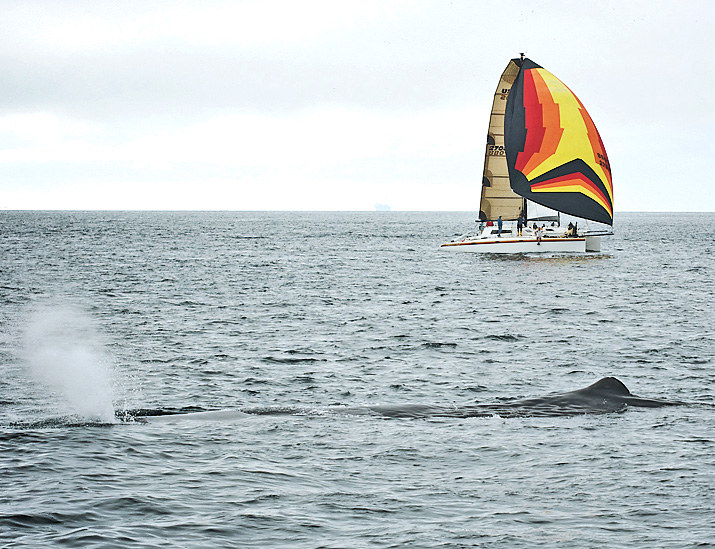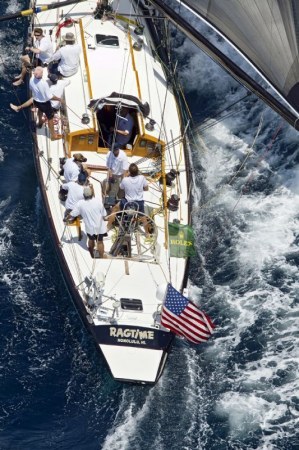
Cruising the Corinth Canal
When you say "the Canal" in the Americas, everyone assumes you’re referring to the Panama Canal. But when you’re in the Med and you say "the Canal," many sailors will understand you to mean the Corinth Canal, the 3.9-miler that connects the Gulf of Corinth with the Saronic Gulf of the Aegean Sea.
Built in the late 1800s, the Corinth Canal saves vessels from having to make a 430-mile journey around the Peloponneusus and up to important destinations such as Athens. Alas, it’s only 79 feet wide and 26 feet deep, so although 11,000 vessels pass through each year, they’re smaller ships, tourist vessels and yachts. A transit costs about $350 U.S.
The Pimentel family — Rodney, Jane, and sons Leo and RJ — of the Alameda-based Leopard 47 Azure II recently passed through the Corinth Canal as they are nearing the end of their two-year Carib/Med cruise, and created the accompanying video. Although the focal length of whatever lenses they used flattened the 150-ft high sandstone walls of the Canal, we thought the video was very, very funny.
In fact, we sent a copy to our kids, with whom we transited the Canal 20 years ago aboard the Ocean 71 Big O. They found it equally hilarious, and it touched off countless memories. In fact, about the only thing Lauren and Nick can remember from that summer two decades ago was of our cruising adventures in Greece and Turkey. We think that’s noteworthy.
The Corinth Canal is unique in that it has submersible bridges at each end, which, when lowered, allow vessels into the sea level canal. When the bridge is raised, children often run out on the roadbed to collect fish that got caught on it. Perhaps the most unusual type of ‘fishing’ we’ve ever heard of.
Treasure Island Plan Approved
The San Francisco Board of Supervisors unanimously approved a massive redevelopment project for Treasure Island yesterday. Featuring 8,000 new housing units in a cluster of high rise buildings, the centerpiece will be a 450-ft tall tower that will dwarf Yerba Buena Island. Fifteen years in the making, the plan includes housing for an estimated 19,000 new residents, plus over 300 acres of park and open space, a 400 slip marina, grocery store, and school, all of which will be built over the next 20 to 30 years. According to a report in the San Francisco Chronicle, "a seawall will guard against sea level rise and possible tsunamis."
As a concept the $1.5 billion project has merit — it’s intended to be a very green development — but the practical considerations seem to have been a little whitewashed. For one, a presumed reliance on public transportation, cycling, and a new ferry terminal seems naïve, and we can’t help but think this will turn the bridge into even more of a parking lot than it already is. As for seawalls protecting against sea level rise and tsunamis . . . just ask Japan how that worked out. And perhaps more fundamental is the question of who would want to live in what will reliably be the absolute coldest, windiest zip code in San Francisco during the summer? And the idea of squeezing in a 400-slip marina without negatively affecting one of Bay’s favored anchorages or the Treasure Island Sailing Center’s training ground — and let’s not mention the massive amount of dredging that would be needed to get boats in those slips — seems optimistic, to say the least. But who knows what the future of the project will hold? There are undoubtedly many moving parts that will likely be adjusted down the line.
Do you have any strong feelings either way? If so, we’d love to hear about them.
Sanctuary Speed Limits
The good news is that whale populations on the West Coast are increasing. The bad news is that there is a corresponding increase in ship strikes. "Ship strikes are now one of the leading threats to whales migrating through California’s waters," says a press release issued jointly by the Environmental Defense Center, Center for Biological Diversity, Friends of the Earth, and Pacific Environment. The groups report that more than 50 whale deaths have been attributed to commercial shipping in the last decade — and that doesn’t take into account unreported cases, of which the groups suspect there are many.

© Latitude 38 Media, LLC
That’s why the group filed a petition Monday — just in time for World Oceans Day, which is today — with the federal government to set a mandatory speed limit of 10 knots for large commerical vessels traveling though California’s marine sanctuaries: Channel Islands, Monterey Bay, Gulf of the Farallones, and Cordell Bank. “Reducing ship speed is a simple, reasonable way to protect whales and other aquatic life, as well as public health, from risks posed by large vessels that travel through California’s waters,” said Marcie Keever, director of the Oceans and Vessels Project at Friends of the Earth.
The petition argues that slower speeds would allow whales to detect and move away from ships before being hit. Added bonuses would be less air and noise pollution, and increased fuel efficiency.
The shipping industry is opposed to the speed limit, saying there’s little evidence that slow speeds through the 9,300-square miles of sanctuaries would reduce ship strikes. Instead of slowing down, which would delay shipments, commercial vessels would likely skirt the sanctuaries altogether, leaving whales outside the areas at risk. Indeed, ships have routinely ignored a voluntary speed limit advised by NOAA through the Santa Barbara Channel during the height of the migration season.
NOAA says it is also concerned with whale ship strikes and will review the petition. If adopted as written, the speed limit would apply to "vessels greater than 65 feet" — which means Chris Welsh’s Newport Beach-based Spencer 65 Ragtime might not need to file for redress in offshore races!

